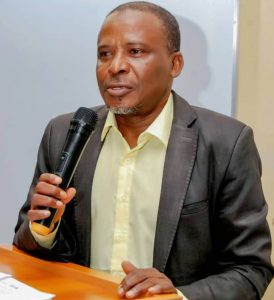Stories about Digital Marginalization By Y. Z. Ya’u, CITAD, Kano, Nigeria
On Thursday, December 28, the Centre for Information Technology and Development (CITAD) held an experience sharing session for the beneficiaries of its Digital Policy Leadership Analysis and VoiceActivation Training at the Command Guest House, Bauchi. The objective of the meeting was to hear stories of engagement from the beneficiaries since the training that held earlier in October.
The Digital Policy Leadership Analysis and Voice Activation Training is part of a broader project entitled Developing Digital Policy Leadership Among Young women, that CITAD has been implementing with support from the Association of Progressive Communication (APC) whose objective is to contribute to addressing the gender digital divide by drawing attention to the absence of women in the digital leadership structure of the country.
The logic of the project is that unless we have women in digital leadership and policy positions, we will not be able to develop and implement appropriate policies and initiatives that will address the gender dimensions of the digital divide in the country. For now the policies and initiatives are developed with at best gender insensitivity mindset but at worse with an attitude to maintain patriarchal privileges accrued to men because of their dominance the policy making space in the country.
One of the key challenges of even comprehending the gender digital divide is the lack of data. Only twoweeks earlier, the Washington-based Portulans Institutereleased the 2023 global network readiness index (NRI) in which Nigeria was not only lowly ranked 106 out of 131 countries but also scored zero in the Gender gap in Internet use sub-pillar, indicating that there was either no data or the data was not sufficient to award any point for the country in that important sub-pillar.
To have a clear understanding of the presence of women in digital leadership positions in the country, CITAD, as part of the project, commissioned a head count survey of the presence of women in the management and boards of eight national ICT agencies and authorities in the country. These included the Ministry of Communication, Innovation and Digital Economy, National Information Technology Development Agency (NITDA), the Nigerian Communication Commission (NCC) and the NigeriaIdentity Management Commission. Others were the National Data Protection Commission, Nigerian Communication Satellite Limited (NICOMSAT), Nigerian Postal Service (NIPOST) and the Universal Service Provision Fund (USPF).
The findings were sobering. For example, out of 19 board members of NITDA, only two are females, and out of 21 management heads, only four were females. Similarly for Nigerian Data Protection Commission (NDPC), out of 42 management members, only eight were women. The Universal Service Provision Fund (USPF) has a Board of 11 members with only one female member while for the management the number is similarly one out of 10 is a woman. The sector regulator, Nigerian Communication Commission does not do better as out of its 17 board members, only one is a female.
The stories told at the experience sharing meeting by the trained champions were equally sobering as intriguing, often bringing the invisibility of the gender digital divide to live. Raihanatu Mohammed Hamid, an academic with the College of Education Billiri, Gombe State told of the story of how she was removed as the Head of the ICT Directorate of her institution(even as she was the only qualified person) because thehead said he did not like women in important positions (as they go for maternity leave). Not surprising, they waited until she took per maternity leave for them to remove per permanently from the position and moved her to head the SIWES (Student Industrial Work Experience Scheme) Unit.
Maimuna Sulaiman, a Pharmacist and ProgrammsDirector at She&Tech, Dutse Jigawa State told of the sad story of a young woman living in a rural community in the state who could not afford a handset and her husband could not allow her to use his or that of any neighbors. When she developed pregnancycomplications, and there was no help in the community and no one could take her to the hospital because the husband did not give permission. She wanted to call her mother but had no access to handset. By the timeher mother (probably out of motherly instinct) came, it was too late. She died after spending 14 days in coma. That phone which she could not afford could have been her life server.
A journalist from FM Radio, Bayero University, Kano, Maria Shuaibu raised a question which at the timeremained a poser with no clear answer. She observed a lack of women representation at the management levelof the media industry, attributing it to stereotypes that view women as soft and fragile, restricting their leadership roles to the middle tier. The question she raised was where do all the female journalists go after they had attained mid-career positions as they hardly make it to the top.
It was the presentation by Khadija Zangina, a Phdstudent and Research Assistant with the African Centre of Excellence for Population Health and Policy located at Aminu Kano Teaching Hospital , Kano that brought an insight that revealed the answer to the poster byMaria Shuaibu. Miss Zangina started her story by saying that while all others were trying to increase the number of women at the top of the ICT ladder, her focus was not to increase but to maintain the number, arguing that her classmates who studied professionalcourses such as IT, engineering, journalism, etc., were no longer working. They had been sequenced out of work. This made her to ask questions as to why they were not working. It emerged that the working environment is not supportive of the family woman. At entry level, with enthusiasm and an eye for the future, young women are able to cope with the toxic work environment. By the time they get married and have children, they have been able to scrape through middle level positions that do not attract competition and hostility from male colleagues. After this stage, working in an environment that is not supportive of women with children and who face hostile attitude of management and male colleagues, they found that they can no longer cope with the situation, resulting in their quitting.
The narrative that emerged is that the work environment is critical to addressing the gender digitaldivide as well as in ensuring that women are able to make to the top and be in a position to sit on the decision and policy making tables. In this sense, the advocacy for gender digital inclusion and for getting women to be part of the policy instrument, must linkup with the more broader advocacy for a gender friendly work environment and work ethics in the country.
Serah Isaac, a technology change-maker from JigawaState also told a surprising instant of invisibility and normalization of technology assisted gender violence.She narrated how fairly informed women, includinggender activists seem not to aware of Technological Facilitated gender based violence. While the womenare not able to see this menace, its normalization by men was appalling. This normalization she illustratedby relating how when she had advertised a product she was selling on her Facebook profile, a male professional colleague wrote across her picture: “how much?”, implying that she her too was a product to be sold and was asking for the price. When she pointed out this to him that this was violence against her person, he simply shrugged off.
The narrative at some stages could dampen the enthusiasm of the campaigners as the beneficiaries of the digital policy analysis leadership develop programme related their experiences, they talked of hostilities from male colleagues, seniors and evenleaders. Hadiya Usman, a teacher told how a principal of the girls secondary school she went to sensitizewarned her against bringing her feminism to his students. Similarly Hannatu Musa Piri, a lecturer at Gombe State University who decided to take her advocacy to her colleagues, told of how she countered opposition from both young and older colleagues in the university. Hannah Kabarang, founder of Bloom Innovation, Gombe State explained how her efforts to train women living with disabilities were dismissed with derision. Hadiya Usman from Akko Local Government of Gombe said got worried when leaders demanded incentives from her to allow her space to sensitize women about digital issues.
Not all the stories were about opposition and hostility. There were instances of support and appreciation, Halima Sadiya Yahaya from Gombe State found openings from a group of religious leaders. Amb.Maryam ibrahim Sani, a peace campaigner was well received by her traditional rulers who helped her inmobilizing other women to attend her sensitizationsessions. For Sadiya Danyaro, a Phd student and lecturer with the Federal University, Dutse-Ma found an opening from government officials, one of who gave her the draft digital policy for the state to make observation and pointed out to him the lack of any consideration about women and gender issues, which he gladly acknowledged as a gap that needed to be addressed.
Overall, one comes out of the meeting better informed and with a nuanced understanding of the challenges ahead. It was gratifying to see the enthusiasm, passion and the energy as well as the sense of mission that these young ladies exhibited. Surely, we shall overcome.



